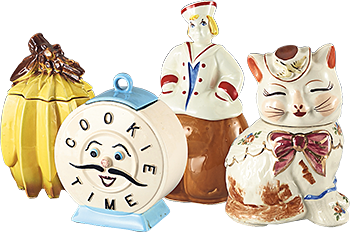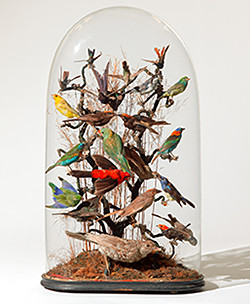The artist as collector at the Barbican

Simply sign up to the Life & Arts myFT Digest -- delivered directly to your inbox.
A great collection often seems to be the result of one very rich man going shopping. It isn’t. It is really partly illness, an incurable obsession. It is so nearly an artistic activity in its own right. It is certainly a disease.”
This is the artist Howard Hodgkin on amassing his Indian miniatures, which are the delightful subject for one of many exhibitions-within-an-exhibition forming the Barbican’s captivating, diverse new show Magnificent Obsessions: The Artist as Collector.
Others range from Martin Parr’s raucous, nostalgic British postcards — a Butlins ballroom, Blackpool night-lights — which parallel his own comic dissections of consumer expectation, to Sol LeWitt’s Japanese prints, wildly contrasting with the sculptor’s abstract pieces yet sharing their formal simplicity.
Artists collect for the same basic reasons as everyone else — possession, obsession — but often with a quirkier visual or intellectual hinterland. “My collection is my mentor,” says conceptual photographer Hiroshi Sugimoto. “It trained my taste and sensitivity.” For years Sugimoto dealt in Japanese Buddhist art, rarely buying photography (“I can easily make it by myself”), but when his own work became expensive, he broadened his arena.
On show here is his box of glass eyes from 1811, an early edition of Newton’s Principia, a Japanese “military optical surgical kit”, and Jacques Fabien Gautier d’Agoty’s glamorous red and white mezzotints “Myologie complète” (1746), depicting the anatomy of muscles in the human head, which look like proto-surrealist fantasies. Sugimoto’s own stark, black and white portrait “Benjamin Franklin”, based on a wax model, hangs alongside. Concerns with perception, claims to truth, nature and history, connect the artist’s creepily fossilised photograph with his strange collection.
Sugimoto shares the Barbican’s opening gallery with Damien Hirst, whose Wunderkammer features a fabulous 19th-century taxidermy lion and a group of skulls, notably that of an alligator who seems to smirk at death. “I love the contrast between the marble and bronze skulls, which have a sense of immortal grandeur, and the real ones, which you just can’t fight with,” Hirst says. “Those Victorian natural history displays are so stupidly self-confident, it’s nature seen through the eyes of man, beautifully ordered according to aesthetics . . . fake places.” His collection, debating art’s mastery — or not — over nature, relates obviously to themes of death and façades of reality in his own famous vitrine series of animals in formaldehyde.
What is surprising, however, are links between Hirst’s collection and those belonging to artists of quite disparate concerns. For example, Hanne Darboven’s installations of handwritten mathematical calculations and musical arrangements were made in a studio, recreated here, that was so layered with diverse kitsch — a Mickey Mouse telephone and a Charlie Chaplin mannequin, candelabra and chamber pots, faux-classical statuary and giant taxidermy beasts rivalling Hirst’s — that it suggests phantasmagoric superimpositions of levels of reality. Darboven dematerialised this abundance in her strict compositions, controlling the physical world by visual austerity: formally, her voyage from narrative to minimalism resonates with Hirst’s and Sugimoto’s.

That journey is echoed again by a British artist born within months of Hirst but reaching conceptual art via a dramatically different route: Edmund de Waal. His quiet, exquisitely arranged vitrine of small white cylinders and plates, called “from the collection of a private man”, is showcased here with his childhood gathering of shells, stones, clay pipes, and a vitrine of the characterful netsuke — rat curled up asleep, stag scratching its ear, wolf resting a paw on a tortoise — that inspired his best-selling book The Hare with Amber Eyes.
Each artist in this show is represented by items from his collection and one art work. At first sight, the overall result looks like Clutter City. Pleasures come from unravelling: initially what artists buy, how they display it, then richer common or opposing seams. Some collections feed an artist’s work directly, others stand defiantly apart from it — for instance, the straightforward representation in Mughal painting contrasts with Hodgkin’s own abstracted painterly ambiguity. Themes shedding light on the creative process and on cultural history make this exhibition, like a fine collection, greater than the sum of its parts.
A superb parade takes place across the gallery’s upper floor. Andy Warhol’s vintage ceramic cookie jars — “Policeman”, “Smiley Pig” — stand in gleaming, grinning rows. Next door are French-born American artist Arman’s rough-hewn wooden-fabric face masks, with hollowed eyes and sometimes human teeth, from Gabon, Tanzania and Ivory Coast, and the Punch and Judy dolls, ventriloquist’s dummy, wrestling souvenirs, Victorian screens, fragments of church pews and industrial signs, assembled over a lifetime by the British artist Peter Blake.

Born between 1928 and 1932, all three artists are Depression-era kids who hoarded as soon as they could. Their art formalises the dreams of plenty and fears of loss embodied in their unrestrained collecting. Arman made obsessive accumulation sculptures such as “Home Sweet Home” (1960), a wooden box displaying gas masks arranged like faces, which oddly shares an aesthetic with his African statuary. Blake’s “Kamikaze” (1965) — a painting-collage featuring a toy Japanese airplane, knitted mask, photographs of pilots — demonstrates how the artist utilises his vast repository in a garrulous oeuvre that turns on social recollection.
Warhol, who went shopping daily and accumulated so many possessions that it took Sotheby’s nine days to sell them after his death in 1987 (a group of cookie jars made $247,830), saw art in terms of consumer desire. His jars point to pop art’s romance with mass consumption, and his collection, distinguished by utter lack of discrimination, reflects pop as an equaliser, levelling Brillo box and Crucifixion. “With Andy,” his friend Jed Johnson recalled, “there was no sense of an object existing by itself and of itself; it only existed as Andy’s thing.”

What does an accumulation of objects mean today, when there is too much stuff everywhere? The Barbican’s youngest artist is Danh Vō, who was rescued at sea as a Vietnamese boat child aged four by a Danish freighter and makes installations about belonging, identity, transformation. “I M U U R 2” (2013) brilliantly converges collection and art work. Its thousands of neatly shelved items — thrift store Buddhas and plastic toys from San Francisco’s Chinatown, a burger lamp stand, crates of paintbrushes — all belonged to artist Martin Wong and his mother Florence. Many were props for Wong’s gritty paintings and, after Wong’s death in 1999, they remained in Florence’s house, as no museum was interested; to secure them as an archive, Vō laboriously turned them into this installation, which was then acquired by the Walker Art Center in Minneapolis.
Gertrude Stein quipped that things are either worthless or priceless. Vō treads the line in between, and asks of all the objects in this compelling exhibition whether a collection orders or enshrines the chaos of memory and imagination.
‘Magnificent Obsessions: The Artist as Collector’, Barbican Art Gallery, London, to May 25, barbican.org.uk
Photographs: Arman Studio Archives/ ADAGP, Paris/ DACS, London; Movado Group; Murderme Collection
Comments